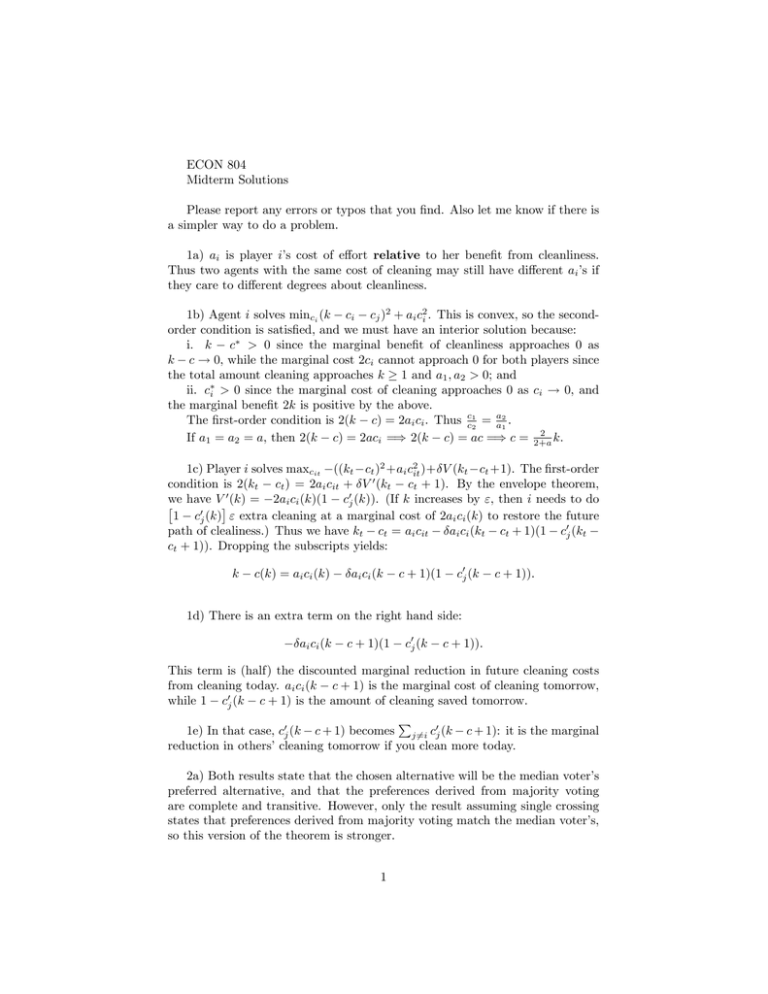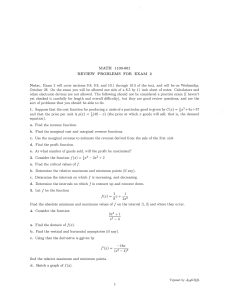ECON 804 Midterm Solutions
advertisement

ECON 804 Midterm Solutions Please report any errors or typos that you …nd. Also let me know if there is a simpler way to do a problem. 1a) ai is player i’s cost of e¤ort relative to her bene…t from cleanliness. Thus two agents with the same cost of cleaning may still have di¤erent ai ’s if they care to di¤erent degrees about cleanliness. 1b) Agent i solves minci (k ci cj )2 + ai c2i . This is convex, so the secondorder condition is satis…ed, and we must have an interior solution because: i. k c > 0 since the marginal bene…t of cleanliness approaches 0 as k c ! 0, while the marginal cost 2ci cannot approach 0 for both players since the total amount cleaning approaches k 1 and a1 ; a2 > 0; and ii. ci > 0 since the marginal cost of cleaning approaches 0 as ci ! 0, and the marginal bene…t 2k is positive by the above. The …rst-order condition is 2(k c) = 2ai ci . Thus cc12 = aa21 . 2 If a1 = a2 = a, then 2(k c) = 2aci =) 2(k c) = ac =) c = 2+a k. 1c) Player i solves maxcit ((kt ct )2 +ai c2it )+ V (kt ct +1). The …rst-order condition is 2(kt ct ) = 2ai cit + V 0 (kt ct + 1). By the envelope theorem, we have V 0 (k) = 2ai ci (k)(1 c0j (k)). (If k increases by ", then i needs to do 1 c0j (k) " extra cleaning at a marginal cost of 2ai ci (k) to restore the future path of clealiness.) Thus we have kt ct = ai cit ai ci (kt ct + 1)(1 c0j (kt ct + 1)). Dropping the subscripts yields: k c(k) = ai ci (k) ai ci (k c + 1)(1 c0j (k c + 1)): 1d) There is an extra term on the right hand side: ai ci (k c + 1)(1 c0j (k c + 1)): This term is (half) the discounted marginal reduction in future cleaning costs from cleaning today. ai ci (k c + 1) is the marginal cost of cleaning tomorrow, while 1 c0j (k c + 1) is the amount of cleaning saved tomorrow. P 1e) In that case, c0j (k c + 1) becomes j6=i c0j (k c + 1): it is the marginal reduction in others’cleaning tomorrow if you clean more today. 2a) Both results state that the chosen alternative will be the median voter’s preferred alternative, and that the preferences derived from majority voting are complete and transitive. However, only the result assuming single crossing states that preferences derived from majority voting match the median voter’s, so this version of the theorem is stronger. 1 2b) Let the set of alternatives be X = fw; x; y; zg, and the set of agents be I = f1; 2; 3g. Consider the following preferences: w 1x 1y 1z x 2y 2z 2w y 3x 3w 3z It is easy to see that these preferences satisfy single peakedness with linear order w < x < y < z, so agent 2 is the median voter. However, they do not satisfy single crossing for any linear order: we know that agent 2 must be the median voter, but z 2 w while w 1 z and w 3 z. The preferences derived from majority voting are x M y M w M z, which indeed do not match the median voter’s. 2c) With X = fx; y; zg and linear order x < y < z, there are only four strict preferences satisfying single peakedness: x y z, y x z, y z x, and z y x. Notice that in this order, they also satisfy single crossing. So when there are only three alternatives, there is no strict preference pro…le with single peakedness but without single crossing. 3a) Note that if any non-permanent member receives more than 0, the coalition of the remaining members can block that allocation. Thus all nonpermanent members receive 0. Every remaining candidate allocation is in the core: only coalitions that include all permanent members can generate positive value, but since these coalitions receive 1 in every remaining candidate allocation, they will never block. Thus the core is X fx 2 R15 jxi = 0 if i 2 = P , xi 2 [0; 1] if i 2 P , and xi = 1g: i2P 3b) Any non-permanent member is pivotal if and only if it is the 9th country and all …ve permanent members are in the …rst 8. There are 85 5!9! ways in (8)5!9! 120 which this can happen, so the Shapley value assigns 515! = 10 11 56 12 13 14 15 = 4 4 1 4 421 10 2145 ) = 51 2105 11 13 15 = 2145 to non-permanent members and 5 (1 2145 = 2145 to permanent members. 3c) See notes for the statements. i. Universal domain (an outcome is always achieved) and positive responsiveness (social indi¤erence is impossible, so just need that voting YES doesn’t hurt) ii. Neutrality (it’s easier for a motion to fail than to pass) and symmetry (permanent vs. non-permanent members) 3d) UD: Social preference never de…ned N: Resolutions always pass S: Serial dictatorship (simple dictatorship fails PR) PR: Social preference always indi¤erent 2








